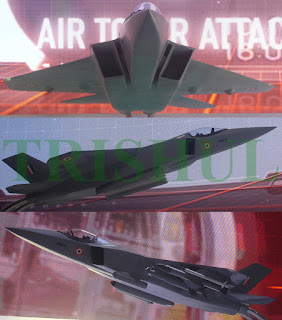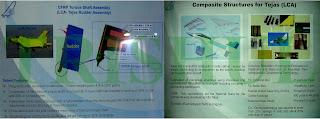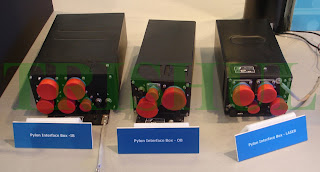Interestingly, the IAF has mandated that IF the fifth-generation
AMCA is to be indigenously developed by ADA, then use must be made of F414-GE-INS6
turbofans for that portion of the flight-test regime that is dedicated to the optimisation
of the medium-weight AMCA’s airframe (the Su-57 FGFA on the other hand is a
heavyweight fifth-generation MRCA), flight-control logic and the digital fly-by-wire
flight control system.
What Is Required For Design/Performance Optimisation
Of LCA-AF Mk.2
For achieving the required
angles-of-attack, instantaneous/sustained turn-rates and climb-rates (i.e.
agility metrics), the LCA-AF Mk.2’s airframe will have to sport LEVCONs of the
type already developed for the IN’s LCA (Navy) Mk.1 MRCA.
For all-passive target
acquisition-cum-tracking beyond the range of the biological Mk.1 eyeball, an
infra-red search-and-track sensor will have to be mounted aft of the
nose-section and just ahead of the nose landing gear section, since this will
get rid of the obstruction of field-of-view posed by the fixed aerial
refuelling probe (supplied by UK-based Cobham) mounted in the MRCA’s starboard
side. Two IRST sensor options ought to be explored for installation: either
UK-based Selex ES’ Skyward, or the IRST-21 from Lockheed Martin.
The selected IRST sensor will have to be
seamlessly integrated with the Elbit Systems-developed TARGO helmet-mounted
display system (HMDS) so that it can present a synthesized image of the tracked
target on the HMDS’ visor along with superimposed fire-control cueing data required
for slaving the IIR sensor on-board the all-aspect RAFAEL-built Python-5 SRAAM when
operating in both lock-on-before-launch and lock-on-after-launch modes.



For the on-board AESA-MMR, the modes of operation
should include multi-target detection and concurrent tracking/fire-control (for
mid-course guidance for the Astra-1 BVRAAM), terrain avoidance, weather search,
traffic collision avoidance, moving ground target indication, Doppler
beam-sharpening, and synthetic aperture ground mapping. Although the DRDO’s
LRDE laboratory began developing the ‘Uttam’ AESAR-FCR since 2012, its
full-scale model displayed at the Aero India 2017 expo in Bengaluru last
February revealed that a lot more work is required in the area of weight
reduction. In addition, unless an environment control system (ECS) is
indigenously developed for meeting the AESAR-FCR’s co9oling requirements,
additional developmental work will have to be undertaken to integrate the
AESAR-FCR with an imported ECS.


This, in turn, will necessitate the acquisition
by the DRDO’s LRDE and CABS laboratories of a turbofan-powered airborne testbed
that, apart from hosting the prototype AESAR-FCR/ECS combination, will also have
to accommodate all the data servers required for the real-time
recording-cum-monitoring of all the performance parameters of the prototype
AESAR-FCR/ECS combination. An alternative option—if available—would be to ship
the prototype AESAR-FCR/ECS combination abroad to a country which is willing to
offer the services on a commercial basis of a suitable airborne test laboratory.
The ADA-designed cockpit for the LCA-AF
Mk.2 (which was unveilled in 2013) has already been deemed as ‘deficient’ by
the IAF, which has since then been showing its preference for the Cockpit-NG
suite that was originally developed by Israel’s Elbit Systems and can easily be
provided by the HALBIT joint venture of Elbit Systems and HAL.
In fact, the IAF
also prefers the same Cockpit-NG suite for the F-16 Block 70s that are on offer
from Lockheed Martin and it needs to be noted that Elbit Systems had originally
developed the Cockpit-NG suite for the global F-16 mid-life upgrade market, and
now even Saab has selected the Cockpit-NG for its JAS-39 Gripen-Es.
For comprehensive self-protection, the
LCA-AF Mk.2 will be required to internally accommodate a wide-band
self-protection jammer, integrated digital radar warning receivers-cum-jamming
transmitters, laser warning receivers and missile approach warning system (MAWS)
sensors (similar to what Sweden’s SaabTech has developed and is now supplying
for installation on-board the HAL-developed Rudra, LCH and LUH helicopters).
While the DRDO’s Bengaluru-based DARE laboratory has already developed the
jammer as well as the integrated digital radar warning receivers-cum-jamming
transmitters (that have already been installed on the upgraded Jaguar
IS/DARIN-3 flying prototypes), the LEDS laser warning receiver will have to
come from SaabTech, with the MAWS being the AAR-60V2 MILDS-F from Cassidian of
Germany.
The LCA-AF Mk.2’s airframe will be
required to internally host four integrated digital radar warning receivers-cum-jamming
transmitters, two LEDS laser warning receivers (preferably on re-designed
wingtips) and six MAWS sensors in a distributed-architecture layout in order to
ensure all-aspect hemispheric coverage.
The LCA-AF Mk.2’s airframe will be
required to internally host a new-generation jet-fuel starter, as well as an
on-board oxygen generation system (OBOGS).
The DRDO-developed aircraft stores
release and ejection mechanism (ASREM) will have to be incorporated into yet-to-be-developed
dual ejector-racks and triple-ejector-racks similar to RAFAUT of France’s
AT-730 triple ejector-rack (that contains three TG-480 ejectors) and AUF-2 dual
ejector-rack.
Incorporation of an actuated cockpit
canopy opening/shutting mechanism, along with a retractable aerial refuelling
probe (also available from Cobham), should be desirable for incorporation as
well.
It is only after incorporation of all
the above-mentioned elements that a final call ought to be taken on the
required quantum of fuselage stretch and increase in wing area of the LCA-AF
Mk.2. It, therefore, may well be that the current estimate of a 1-metre
fuselage stretch required for incorporation is premature and needs to be worked
out again in finer detail in close consultations with the IAF and IN.
List Of Major Sub-Systems On Tejas Mk.1
Composites-Based Airframe Content
DRDO-Developed Components
Involved Private-Sector/Public-Sector Industrial Vendors
Critical Foreign Components On Tejas Mk.1
The image below depicts the airframe design of the LCA that was proposed to ADA by GE Aero Engines way back in 1987. Had this design been adopted by ADA then itself, several of the aerodynamic shortcomings witnessed later in the ADA-designed Tejas Mk.1 L-MRCA could have been eliminated at the very outset.
And this is what the IAF had in mind when it was decided in the 1970s to indigenously develop the LCA.
And finally, the F-16 Block 70 on offer to the IAF has the potential of being upgraded to the F-16U Falcon-21 configuration during its projected mid-life deep upgrade, which is explained below in graphic form.
The F-16U Falcon-21 had been designed by Lockheed Martin as far back as the early 1990s and it can accommodate several of the fifth-generation sensor-fused avionics that are presently on-board the F-35 Lightning JSF family of MRCAs.







































































































